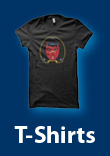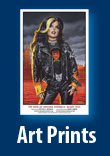How do you break into comics? It’s a question that fledgling writers and artists have been asking since Superman smashed up that automobile on the cover of Action Comics #1, back in 1938. The general response these days is that you should start out by making your own comics, improve your craft with each project, and hope it catches the eye of an editor at one of the big publishers (it holds true for book publishing as well). With the advent of webcomics and print-on-demand publishing, that goal is a lot easier to reach now than it was for me back in the early 1990s.
In 1991 I was one of those low-tech small-press publishers, printing out issues on photocopiers and hand-stapling each book (yes, back When Dinosaurs Ruled the Earth!) to sell by mail order and at conventions. Having already launched my succubus character, Lorelei, I then set about creating another supernatural femme fatale that I could write and draw.
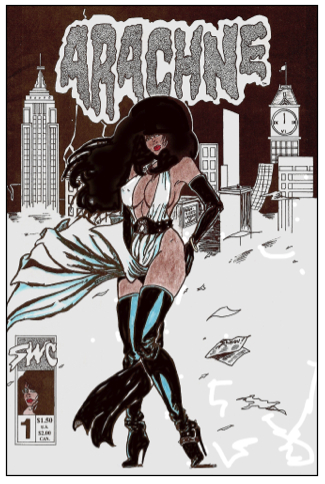 Arachne, like Lorelei, was inspired by Vampirella (the outfit should have clued you in immediately), but rather than being a succubus or vampire Arachne (her real name!) was a truck-stop waitress, and the daughter of a superheroine who had recently passed away. The story begins when one of her mother’s old enemies, The Monster Maker, shows up at her job to enact some long-desired revenge…
Arachne, like Lorelei, was inspired by Vampirella (the outfit should have clued you in immediately), but rather than being a succubus or vampire Arachne (her real name!) was a truck-stop waitress, and the daughter of a superheroine who had recently passed away. The story begins when one of her mother’s old enemies, The Monster Maker, shows up at her job to enact some long-desired revenge…
I debuted the comic at the 1991 New York Great Eastern Convention. I didn’t sell many copies, but the concept of an African-American horror heroine got me some attention, and a fair number of compliments. One of the latter came from a new publisher named Nabile P. Hage, a former U.S. Army officer whose company Dark Zulu Lies had recently launched with Motorbike Puppies, a series about a group of militaristic, anthropomorphic badasses. Think of it as a hybrid of the Teenage Mutant Ninja Turtles, the A-Team, and 1970s blaxploitation movies—only the characters are mutated dogs.
After reading Arachne #1, Nabile’s pitch to me was simple: Dark Zulu Lies was dedicated to promoting black characters to a black readership, in a comics market whose hero population was almost exclusively white. (Keep in mind, this was almost two years before DC Comics launched its Milestone Media imprint, so Nabile was something of a trendsetter.) Motorbike Puppies was his first step toward reaching that audience, to be followed by a title called Zwanna, Son of Zulu. He went on to say that Arachne, as a woman of color, would fit in perfectly with his publishing plans.
Well, that certainly got my interest.
We talked for a bit about Arachne and in what directions DZL’s potential first female headliner could go. However, as Nabile explained, before we could firm up plans he needed some help on his own project—the penciler of Motorbike Puppies had stepped down after beginning the second issue, and Nabile needed an artist to finish it.
Yes, he meant me.
Ladies and Gentlemen, I give you Motorbike Puppies #2, my professional comics debut.
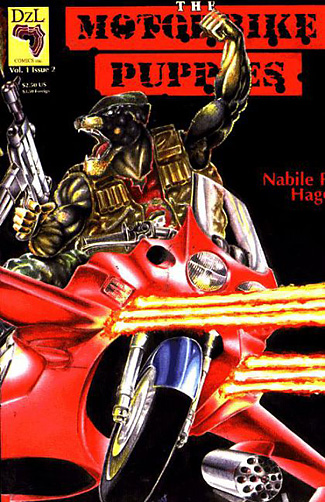 Now, don’t get excited, I wound up drawing only three pages (as well as badly coloring and lettering a majority of the issue); the balance was completed by John Ruiz (Zwanna’s artist) and Dan Peters (who also colored Heartstopper: The Legend of La Bella Tenebrosa #1, which you can find on our Free Comics page). But see that cover? That was the best part of the entire issue. 😀
Now, don’t get excited, I wound up drawing only three pages (as well as badly coloring and lettering a majority of the issue); the balance was completed by John Ruiz (Zwanna’s artist) and Dan Peters (who also colored Heartstopper: The Legend of La Bella Tenebrosa #1, which you can find on our Free Comics page). But see that cover? That was the best part of the entire issue. 😀
My association with Nabile didn’t end with dogs riding motorcycles, though. After Puppies #2 was handed in we talked some more about Arachne’s proposed debut under the DZL banner, but he was more interested in my pitching in again to help out the company’s other title…
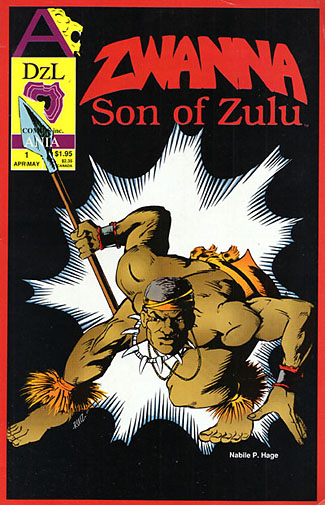 Zwanna, Son of Zulu #1 might go down in history as one of the worst comics ever produced—words like “racist,” “sexist,” “embarrassing,” and “homophobic” tended to pop up in reviews when discussing Nabile’s script, in which every white character was either stupid or gay (or both) and outright evil. In hindsight I should’ve turned down the assignment—these days I certainly would—but at the time I was just happy to get paid for coloring and lettering the thing. (Also, I thought the comic was too stupid to ever be taken seriously.) And, of course, there was the continued promise of Arachne becoming Dark Zulu Lies’ first superheroine…
Zwanna, Son of Zulu #1 might go down in history as one of the worst comics ever produced—words like “racist,” “sexist,” “embarrassing,” and “homophobic” tended to pop up in reviews when discussing Nabile’s script, in which every white character was either stupid or gay (or both) and outright evil. In hindsight I should’ve turned down the assignment—these days I certainly would—but at the time I was just happy to get paid for coloring and lettering the thing. (Also, I thought the comic was too stupid to ever be taken seriously.) And, of course, there was the continued promise of Arachne becoming Dark Zulu Lies’ first superheroine…
Zwanna really is a god-awful comic—with its offensive stereotypes and bad writing it makes Motorbike Puppies look like an Alan Moore project in comparison. Still, it did get attention, which may have been Nabile’s intent all along—controversy will always trump quality, and like the saying goes, bad press is just as helpful as good press…as long as the reporters spell your name right. But hey, at least he tried his best to promote his work, and his cause, even getting arrested at one point by dressing up as Zwanna and climbing the Georgia state capitol. Let’s see Joe Quesada or Dan Didio try something like that!
The amusing part about the whole adventure? For a publishing company dedicated to promoting African and African-American characters—an admirable goal that mainstream comic companies still haven’t made any great inroads toward after the shuttering of Milestone—everybody who worked for Dark Zulu Lies was white. (Except for Nabile, of course.)
Soon after Zwanna #1 came out Nabile gave up his comic-publishing dreams, shut down Dark Zulu Lies, and moved to Liberia, where he became a much more successful businessman—and apparently met a tragic end. While Goggling his name for this post, I discovered he might have died in 2003 after being kidnapped by rebel forces during a skirmish with Liberia’s military; the U.S. State Department still lists him as missing.
That is… not how I expected this story to end. Sorry about that; it was a major shock to me, too.
Tomorrow, we’ll try and lighten the mood with the story of a Spider-Man novel that I almost wrote.

